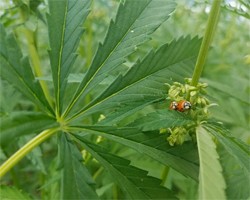Edible Hemp Foliar Sampling Project 2018
Judson Reid, Extension Vegetable Specialist, Team Leader
Harvest New York

Hemp, a multi-use crop that has been cultivated for centuries, is increasingly cultivated in New York. 'Industrial hemp' is a non-intoxicant version of Cannabis sativa with potential use as fiber, grain or processed consumer products. Hemp is a controlled substance, regulated by the US Drug Enforcement Agency. New York is one of the states with a sanctioned program to study growth, cultivation and marketing of the crop.
In 2018 CCE worked with two farms in Central and Northern New York to begin to understand nutrient dynamics in the production of edible hemp. The end product may be a microgreen for salad style consumption, juice or smoothies; or formulated into other edible products. Although we initially began to work with microgreens, farmers have found interest in edible portions of later stages of crop growth too. In both situations the crop was grown inside a greenhouse; one in mineral soil, the other in potting soil.
Foliar sampling is a common crop management tool, particularly for greenhouse and high tunnel vegetables. Coupling a soil test with regular foliar tests, farmers can observe nutrient trends within the crop and make mid-stream adjustments before deficiencies or toxicities become visible and cause a yield loss.
The data shared in this final report is an average of foliar nutrient values throughout the growing season. In this initial year of testing we observed the following trends:
- Both farms were near the lower range of sufficiency for nitrogen.
- Hemp grown in potting media tested lower in magnesium and calcium.
- The farm with mineral soil was deficient in foliar levels of phosphorus and potassium, due to low soil phosphors and potassium levels, high soil calcium and lack of fertilization.
- Both farms showed lower levels of the micronutrient manganese; likely due to high water pH/alkalinity and soil calcium levels.
Read details about the study and see charts on the macronutrients, secondary nutrients, and micronutrients in the final report found below.
Edible Hemp Foliar Sampling Project 2018 (pdf; 278KB)
Upcoming Events
Whole Farm Climate Adaptation and Mitigation Planning (CAMP) Series
January 13 - February 12, 2026
Jan 13, Jan 29: 10:00 AM - 4:00 PM; Feb 12: 1:00 - 4:00 PM
Kingston, NY
Join CCE Ulster and CCE Harvest New York for a three-part workshop series focused on building climate resilience on your farm. We will cover climate change adaptation and mitigation strategies, learn how to access relevant historical climate data, and begin a climate adaptation plan for your farm!January 13 (Tues): 10:00 AM - 4:00 PM
January 29 (Thurs): 10:00 AM - 4:00 PM
February 12 (Thurs): 1:00 PM - 4:00 PM
